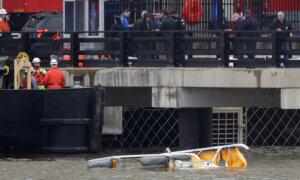NTSB Reports Tourist Helicopter in Deadly New York Crash Was Without Flight Recorders
The NTSB also stated that ‘No onboard video recorders or camera recorders have been recovered.’
As divers continue to utilize “side-scanning sonar” to search the Hudson River for remnants of the tourist helicopter crash that occurred last week, claiming the lives of six individuals, the National Transportation Safety Board (NTSB) announced on April 12 that the aircraft lacked flight recorders.
Divers from the New York Police Department are still on the lookout for the helicopter’s main rotor, main gear box, tail rotor, and a significant section of the tail boom, employing side-scanning sonar to locate potential wreckage. The recovery efforts are ongoing as of Sunday, according to the NTSB.
To date, divers have retrieved the main fuselage, including the cockpit and cabin, the forward section of the tail boom, the horizontal stabilizer finlets, and the vertical fin. The NTSB indicated that some of the recovered components will be sent to its laboratories in Washington for detailed examination.
The agency reported that its investigators convened with representatives from the helicopter’s operator, New York Helicopter Charter Inc., to review operational records, policies and procedures, safety management systems, and the pilot’s qualifications. The NTSB will also evaluate two comparable helicopters.
The Federal Aviation Administration, Bell Helicopter, and Rolls Royce are involved in the investigation. The NTSB mentioned it will provide more information as it becomes available.
Six individuals lost their lives when the helicopter plunged into the Hudson River near Manhattan on April 10. The event transpired at 3:17 p.m. on Thursday near the West Side Highway and Spring Street on Manhattan’s west side, as reported by the New York Police Department.
He, along with his wife, Merce Camprubi Montal, and their three children, aged 4, 5, and 11, perished along with the pilot, who was 36 years old.
Jennifer Homendy, chair of the NTSB, stated on Friday that the pilot, Seankese Johnson—a veteran of the U.S. Navy—obtained his commercial pilot license in 2023 and had logged approximately 800 flight hours by March.
Katabella Roberts contributed to this report.





